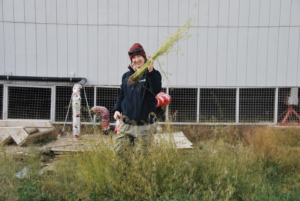The 150-day C3 expedition was an incredible opportunity to collect a wide variety of different plants from across Canada, and in order for those specimens to be archived and be of use they must first be mounted and digitized. It was my great privilege to work on preparing this collection which has allowed me, and hopefully many others, to learn a considerable amount about the stunning diversity of plants to be found on each of this country’s three coasts.


Both ends of the process (Photos: Ed Hendrycks and Alice Durkin)

First, the plants collected on the C3 voyage are identified by some of the wonderful researchers that work at the Museum of Nature – Jeff Saarela, Paul Sokoloff, and Roger Bull. There were close to 850 different samples of vascular plants collected, each sample needing to be mounted on its own sheet of archival paper. Many of these also have duplicates (in some cases as many as 11) which can be sent to other institutions or researchers who will make use of them. Once the plants have been given identification labels they are attached to sheets of archival paper using either linen bands or are sewn into the paper using thread if they are an awkward shape or size.
 When it comes to mounting, not all plant specimens are created equal; this collection contained a large number of grass specimens, which can prove challenging when it comes to fitting them on the page, or moss campion which are beautiful but tend to have been collected in small but bulky clumps. Other plants are much simpler, dogwood leaves and stems tend to lay flat, as do bellflowers. If a sample is being particularly stubborn then weights can be used to hold it down until it can be secured. Each sheet of archival paper is prepared with a barcode that will identify that specific specimen within the museum’s archives, and after this is entered into the system the mounted specimen can be imaged. Taking a high quality photograph of the plant specimen enables it to be used by researchers from further afield, and for those who cannot access the collection in person. This image is then attached to the digital file belonging to the plant and can be archived. Once everything is secured and the information has been recorded it can be entered into the museum’s database.
When it comes to mounting, not all plant specimens are created equal; this collection contained a large number of grass specimens, which can prove challenging when it comes to fitting them on the page, or moss campion which are beautiful but tend to have been collected in small but bulky clumps. Other plants are much simpler, dogwood leaves and stems tend to lay flat, as do bellflowers. If a sample is being particularly stubborn then weights can be used to hold it down until it can be secured. Each sheet of archival paper is prepared with a barcode that will identify that specific specimen within the museum’s archives, and after this is entered into the system the mounted specimen can be imaged. Taking a high quality photograph of the plant specimen enables it to be used by researchers from further afield, and for those who cannot access the collection in person. This image is then attached to the digital file belonging to the plant and can be archived. Once everything is secured and the information has been recorded it can be entered into the museum’s database.

Some types of plants appear more often than others in the collection, including different types of willow, sedge, potentilla, and fescue. An intention behind this project was to build a record of all plants that are currently growing on our coasts, and there was certainly a large scope of species recovered. The variety of plants collected is stunning; more than once I would be admiring a beautiful flower only to check the label and see that it came all the way from Nunavut! A territory with a value of Zone 0a in plant hardiness… Which only further highlights the importance of such a collection; to increase the knowledge and understanding we have of the rich diversity found within Canada’s borders (including in our more northern provinces and territories), in addition to how important it is to ensure that this rich diversity can be sustained for many generations to come. It has been a privilege to work on pulling this collection together and transforming it into a resource that can be used by researchers and educators alike, sharing and continuing in the legacy of this incredible voyage.
Photo credits: Image 1 & Image 2 (Ed Hendrycks and Alice Durkin) Image 3 (Alice Durkin) Image 4 (Paula Piilonen) Image 5 (Jeff Saarela)
